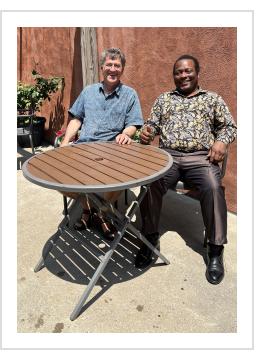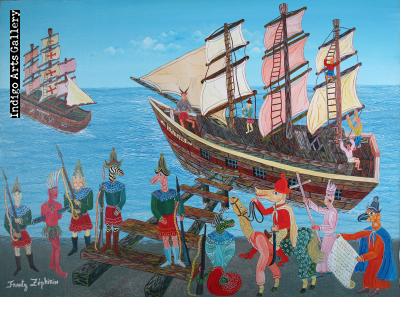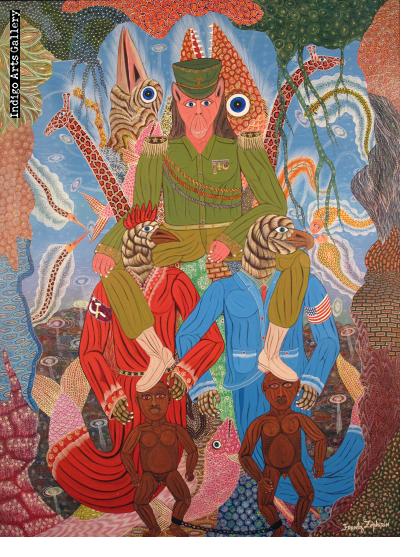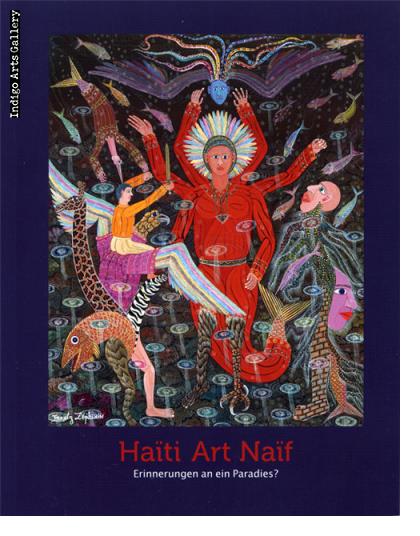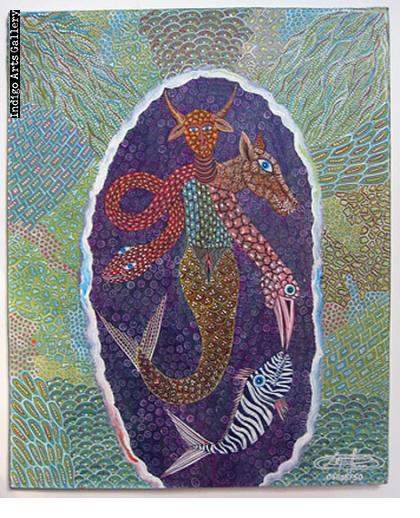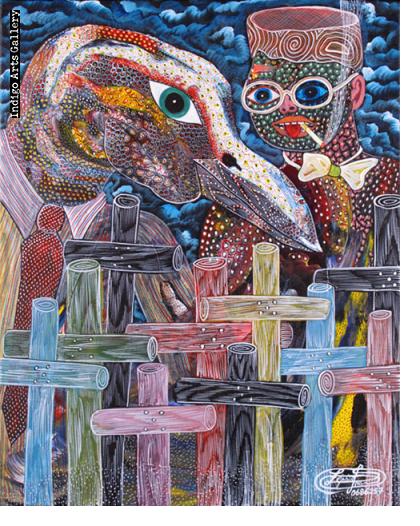About the Artist
Zephirin was born in Cap Haitien, Haiti on December 17, 1968. By his reckoning, he is the 24th of 48 children sired by his architect father (with 19 different women). As a toddler he sat and watched his uncle, the Haitian painter Antoine Obin, as he worked. By the age of seven, Frantz was filching paint in bottlecaps to do his own paintings. Within a year he was selling paintings to the tourists from cruise ships that docked in Le Cap in those days and by age thirteen, lying about his age, he was selling work to galleries. Eventually he moved to Port-au-Prince and became associated with the Galerie Monnin. His style is unique among the painters of the Northern School. He describes himself as a "Historic Animalist". He is entirely self-taught. Unlike many Haitian painters, he usually titles his paintings.
Zephirin counts among his influences Leonardo da Vinci, James Darwin and the Lost Continent of Atlantis. His work is shown internationally. In October 1996 he was awarded the Gold medal in the Third Biennal of Caribbean and Central American Painting, sponsored the The Museum of Modern Art of the Dominican Republic. This competition featured 144 artists from 37 countries in the region. He was one of five Haitians to be included in the V Biennal in Cuenca, Ecuador in 1996. Two of his paintings are featured in the wonderful show "Sacred Arts of Haitian Vodou" that toured the USA in 1997 and 1998. One of his paintings is featured on the cover of the bestseller "The Immaculate Invasion" by Bob Shacochis. His work was shown by the American Visionary Art Museum (Baltiimore) in the exhibits, "Holy H20" in 2005 and "Home & Beast" in 2006-7. Zephirin lives outside of Port-au-Prince, but travels extensively. (biographical notes courtesy of Bill Bollendorf - Galerie Macondo).
Indigo Arts Gallery and art dealer Frank Giannetta presented "Frantz Zephirin: Art and Resilience", the first US exhibit by Haitian master painter Frantz Zephirin since the January 12th, 2010 earthquake. Exhibit dates: Thursday, May 13 through Saturday, June 19. Frantz Zephirin is one of the leading contemporary artists working in Haiti today. A self-taught artist born in Cap Haitien in 1968, Zephirin has variously been described as a visionary, a surrealist, a visual satirist and an “historic animalist”. His work has been featured in museums and galleries around the world.
After a very close call with the earthquake Zephirin immediately went back to work recording his visions of a violently transformed world. His painting, “The Resurrection of the Dead “ was the arresting image chosen for the January 25th cover of the New Yorker magazine. Since the earthquake Zephirin has been featured in stories in the New York Times, Le Monde, the Wall Street Journal, the Los Angeles Times, the Times of London, the Guardian and the BBC - website and broadcast. During March through May, 2010, Zephirin has been exhibiting his work in the exhibit Haiti Art Naif: Memories of Paradise? at the art center Denkmalschmiede Hofgen in Gimma, Saxony, Germany. A portion of the sales of Zephirin’s work will be donated to Haitian earthquake relief.
Zephirin only barely escaped death in the January 12, 2010 earthquake. According to an article in Le Monde, (“Haïti, les peintres de l’espoir” (Haiti, Painters of Hope), by Annick Cojean, Feb. 13, 2010) he responded to the quake, as to other calamities, by painting: Some of these artists, like Frantz Zéphirin and Henri Jean-Louis, began painting feverishly, immediately after the quake, as a way to process the horror they had just witnessed. In the aftermath of the January 12 disaster, Zéphirin took a painting to Pétionville to gallery owner, Michel Monnin; undoubtedly, the article underlines, the first painting to be produced after the earthquake. The painting, full of eyes—eyes of horses, zebras, giraffes, birds, mermaids, specters, and winged creatures—is “magnetic and inspired.” And it is not the only one; there are five or six more in the making. As Zéphirin says, it is impossible for him to do otherwise: “I can only think of this. The earthquake. I walk in the devastated streets, I drink, I think, and I go back to paint. I do not sleep. I paint. I paint like I breathe.” Also a vodou priest, many mythological aspects are present in his work. In his paintings “leaning over the disaster, spirits and gods, struck [by the event], meet, connect, and merge to find a solution to the problem of Haiti.” Zéphirin feels that the earthquake can act as a catalyst to produce deep and positive change. He also wants to convey a message about treasuring ecological wealth and fighting deforestattion. He wants to point out through his paintings that while houses and buildings were crumbling, the trees remained in tact and resisted.”
Shortly after surviving the January 12th 2010 earthquake, Zephirin was honored with the selection of one of his paintings for the cover of the New Yorker magazine. The January 18th story gave New Yorker readers some background on the painting.


